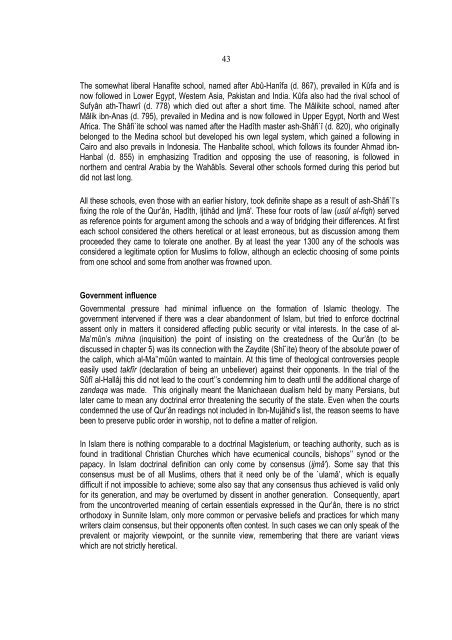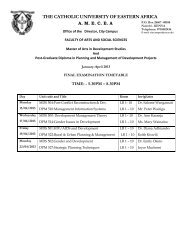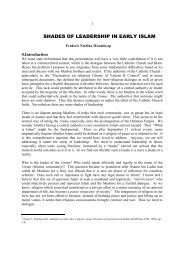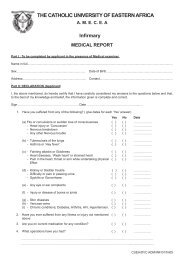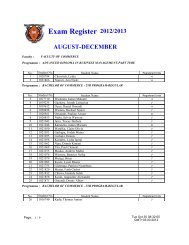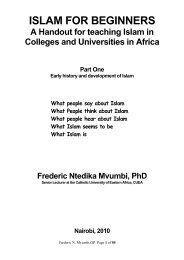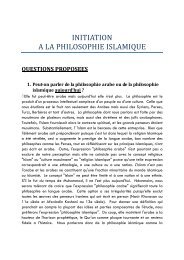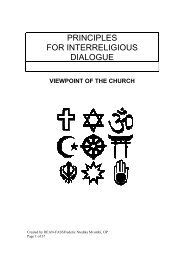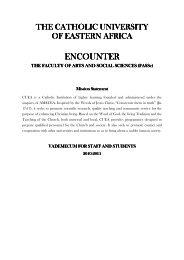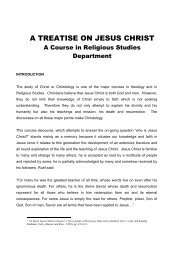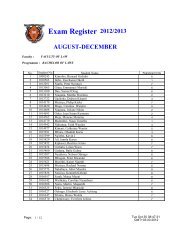INTRODUCTION TO ISLAMIC THEOLOGY.pdf - CUEA
INTRODUCTION TO ISLAMIC THEOLOGY.pdf - CUEA
INTRODUCTION TO ISLAMIC THEOLOGY.pdf - CUEA
You also want an ePaper? Increase the reach of your titles
YUMPU automatically turns print PDFs into web optimized ePapers that Google loves.
43The somewhat liberal Hanafite school, named after Abû-Hanîfa (d. 867), prevailed in Kûfa and isnow followed in Lower Egypt, Western Asia, Pakistan and India. Kûfa also had the rival school ofSufyân ath-Thawrî (d. 778) which died out after a short time. The Mâlikite school, named afterMâlik ibn-Anas (d. 795), prevailed in Medina and is now followed in Upper Egypt, North and WestAfrica. The Shâfi`ite school was named after the Hadîth master ash-Shâfi`î (d. 820), who originallybelonged to the Medina school but developed his own legal system, which gained a following inCairo and also prevails in Indonesia. The Hanbalite school, which follows its founder Ahmad ibn-Hanbal (d. 855) in emphasizing Tradition and opposing the use of reasoning, is followed innorthern and central Arabia by the Wahâbîs. Several other schools formed during this period butdid not last long.All these schools, even those with an earlier history, took definite shape as a result of ash-Shâfi`î’sfixing the role of the Qur’ân, Hadîth, Ijtihâd and Ijmâ'. These four roots of law (usûl al-fiqh) servedas reference points for argument among the schools and a way of bridging their differences. At firsteach school considered the others heretical or at least erroneous, but as discussion among themproceeded they came to tolerate one another. By at least the year 1300 any of the schools wasconsidered a legitimate option for Muslims to follow, although an eclectic choosing of some pointsfrom one school and some from another was frowned upon.Government influenceGovernmental pressure had minimal influence on the formation of Islamic theology. Thegovernment intervened if there was a clear abandonment of Islam, but tried to enforce doctrinalassent only in matters it considered affecting public security or vital interests. In the case of al-Ma’mûn’s mihna (inquisition) the point of insisting on the createdness of the Qur’ân (to bediscussed in chapter 5) was its connection with the Zaydite (Shî`ite) theory of the absolute power ofthe caliph, which al-Ma’’mûûn wanted to maintain. At this time of theological controversies peopleeasily used takfîr (declaration of being an unbeliever) against their opponents. In the trial of theSûfî al-Hallâj this did not lead to the court’’s condemning him to death until the additional charge ofzandaqa was made. This originally meant the Manichaean dualism held by many Persians, butlater came to mean any doctrinal error threatening the security of the state. Even when the courtscondemned the use of Qur’ân readings not included in Ibn-Mujâhid’s list, the reason seems to havebeen to preserve public order in worship, not to define a matter of religion.In Islam there is nothing comparable to a doctrinal Magisterium, or teaching authority, such as isfound in traditional Christian Churches which have ecumenical councils, bishops’’ synod or thepapacy. In Islam doctrinal definition can only come by consensus (ijmâ'). Some say that thisconsensus must be of all Muslims, others that it need only be of the `ulamâ’, which is equallydifficult if not impossible to achieve; some also say that any consensus thus achieved is valid onlyfor its generation, and may be overturned by dissent in another generation. Consequently, apartfrom the uncontroverted meaning of certain essentials expressed in the Qur’ân, there is no strictorthodoxy in Sunnite Islam, only more common or pervasive beliefs and practices for which manywriters claim consensus, but their opponents often contest. In such cases we can only speak of theprevalent or majority viewpoint, or the sunnite view, remembering that there are variant viewswhich are not strictly heretical.


